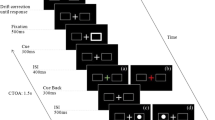Abstract.
Previous research has shown that when subjects search for a particular target object the sudden appearance of a new object captures the eyes on a large proportion of trials. The present study examined whether the onset affects the oculomotor system even when the eyes move directly towards the target. Using a modified version of the oculomotor paradigm (see Theeuwes, Kramer, Hahn, & Irwin, 1998) we show that when the eyes moved to the target object, subsequent saccades were inhibited from moving to a location at which a new object had previously appeared (inhibition-of-return; IOR). Whether or not a saccade to the onset was executed had no effect on the size of the inhibition. In particular conditions, the trajectories of saccades to the target objects were slightly curved in the opposite direction of the onset. The data are interpreted in the context of a novel hypothesis regarding oculomotor IOR.
Similar content being viewed by others
Author information
Authors and Affiliations
Additional information
Electronic Publication
Rights and permissions
About this article
Cite this article
Godijn, R., Theeuwes, J. Oculomotor capture and Inhibition of Return: Evidence for an oculomotor suppression account of IOR. Psychological Research 66, 234–246 (2002). https://doi.org/10.1007/s00426-002-0098-1
Accepted:
Issue Date:
DOI: https://doi.org/10.1007/s00426-002-0098-1




